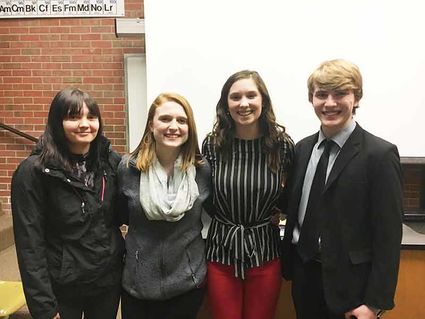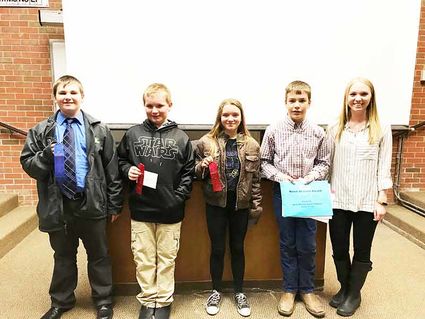Big Sandy's Science Students win at Regional Fair
March 21, 2018

The High School Science Fair students l to r: Cally Demontiney, Jasmine Genereux, Jessica Roth, And Tyler Schwarzbach, the High school students are taught by Melanie Schwarzbach.
As always the Big Sandy Science Students represented us well at the Hi-Line Regional Science & Engineering Fair held at MSU-Northern SUB Ballroom on Monday, March 12 earning all three top places. Melanie Schwarzbach has been the director of the Hi-Line Regional Science Fair for 15 years. The scientist needed to be there by 8:30 am, where their projects were judged for physical presentations, actual testing results and reports, and their oral interviews. The day isn't over till 5:00 that day.
High school presenters were:
Jessica Roth: "The Effects of Sodium Bicarbonate Concentration on the Growth Rate of Chlorella". Awards earned by Jessica US Navy, US Air Force, Ricoh Corporation Sustainability, My Alpha Theta Award, US Metric System Award, and First Place
Tyler Schwarzbach: "The Relationship Between Oil and Biodiesel Quality". Awards earned by Tyler US Navy, US AirForce, and ASU Walton Solutions Initiative awards and Second place
Jasmine Genereux: "The Effects of Gel Fire-retardant in the Regrowth of Plants". Award earned by Association for Women GEO scientists Award and third place.
Cally Demontiney: "Do Sunflowers Absorb Chemicals Efficiently Through the Process of Phytoremediation?"
Grade School Presenters were: Reinhard Bold, "How Do Seed Treatments Affect Duclair Spring Wheat?" Awards earned by Reinhard Purple Ribbon, Broadcom Masters, Best Display, Best Presentation, and 2nd Place for Junior High.
Severin Heimbigner "Sound Goes Tubular". Severin earned a Blue Ribbon.
Hunter Moore: "Wifi: The dangers to Plants". Hunter earned a Red Ribbon and Best Bibliography.
Kadee Sternberg: "Make Abe Shiny again". Kadee earned a Red Ribbon.
First and second places from the Hi-Line Regional Science & Engineering Fair go to the International Science Fair in May in Pittsburg. And for both, Jessica and Tyler it will be the second time they have both qualified.
The high school students and Reinhard will be going to the State Fair on Sunday March 18th through the 20th in Missoula at the U of M.
I asked the top three to explain their projects. Jessica's science project is how baking soda affects the growth of algae. "Over the past few years using algae as fuel has become more possible. The problem with algae is it grows a little slow. Basically, what the baking soda was doing
was to see if it would extend the growth rate with a higher oil production in the same amount of time. I actually got the chance to go up to Northern to work in their bio-diesel lab and that was a lot of fun. We all worked really hard on our projects and I'm glad we did well."
Tyler said, "So the basic idea was to see out of 3 different kinds of base vegetable based oils; being corn, canola, and safflower, which one would create the highest quality of biodiesel? I made the diesel a process known as transesterfication; which means transferring the fat in the oils into an acid and an alcohol. From there I did a series of quality tests which are easy and simple enough for anyone to do at home, assuming they had the materials and knowhow on making the biofuel. By the end of the tests, the safflower ended up being the highest quality of biofuel, as it come out on top in nearly all of the quality tests."

l to r: Severin Heimbigner, Hinter Moore, Kadee Sternberg, Reinhard Bold, and their gifted and talented teacher, Shelbi Darlington.
Jasmine said, "My project consists of the fire-retardants that they spray out of planes to stop fires. One main brand that many people have seen has coloring in it to help the pilots see where they have sprayed. The fire-retardant that I used, FireIce, does not contain any dyes but does contain fertilizers, super-absorbent polymers, and other minor ingredients. The polymers are the same polymers found in diapers; they hold water for an extended period of time and therefore hold water from reaching the plants roots. But, the fertilizers actually helped the growth of one of my species of plants: the wheatgrass. At the end of my project it was seen that the FireIce helped the wheatgrass but killed off the alfalfa, my other species."
So, I know you are all impressed! We should all be! Congratulations to our scientists.




